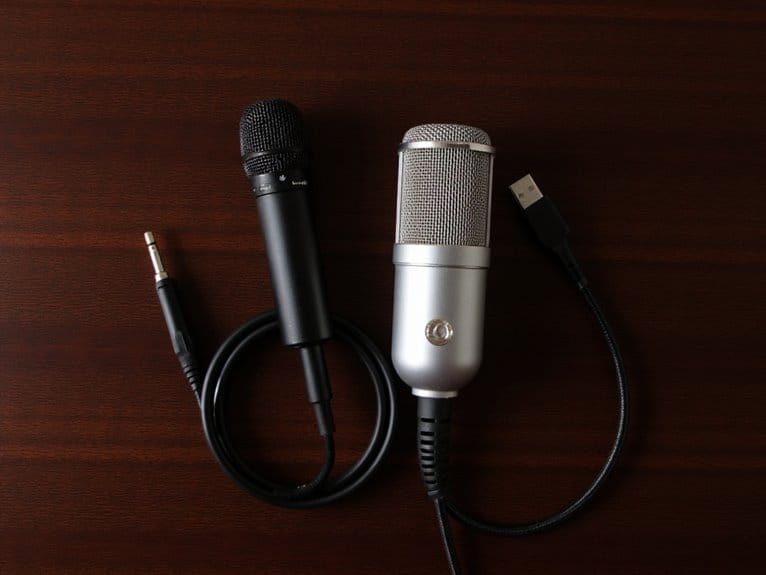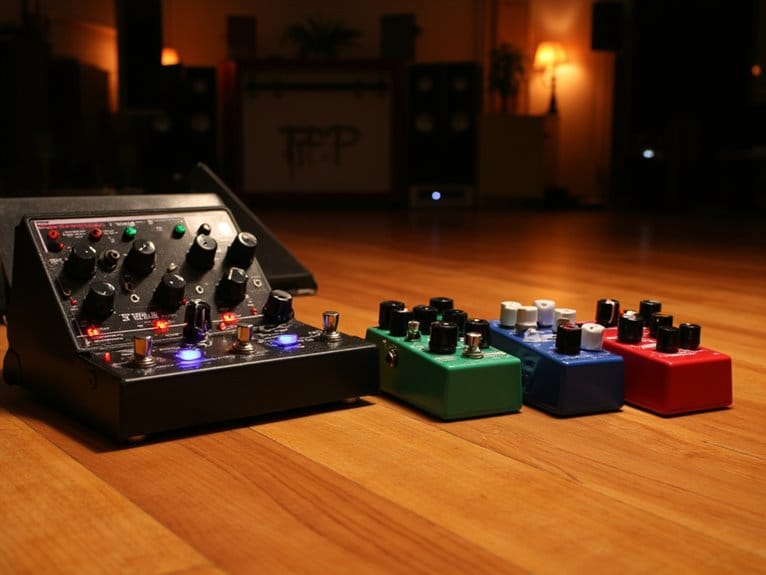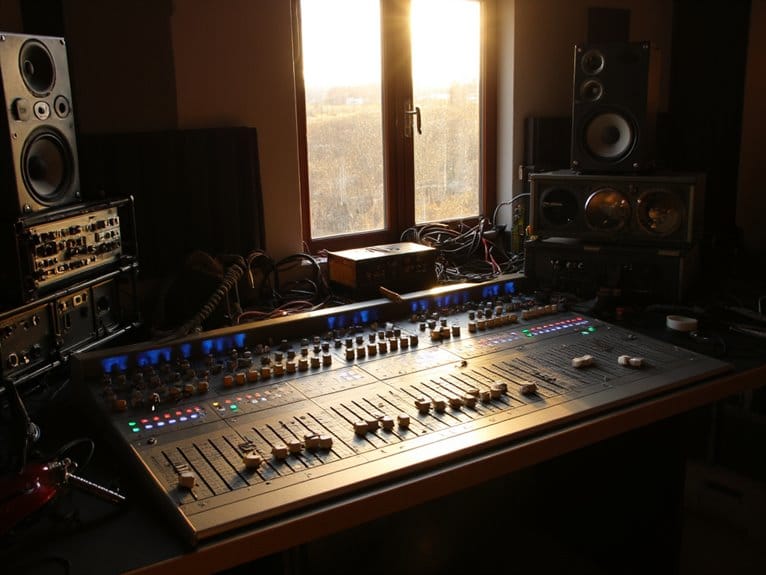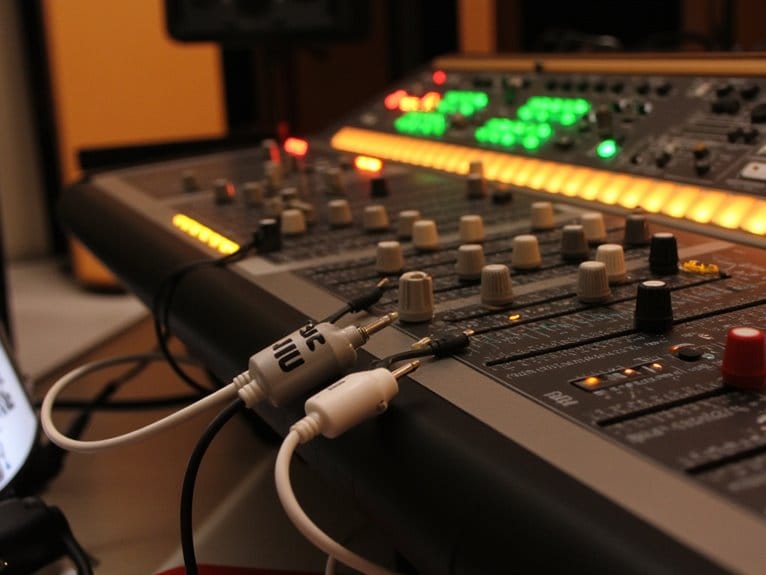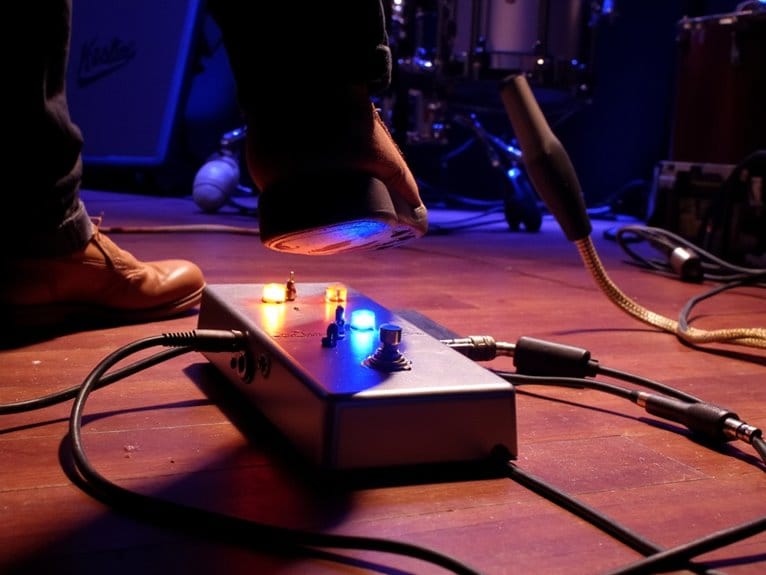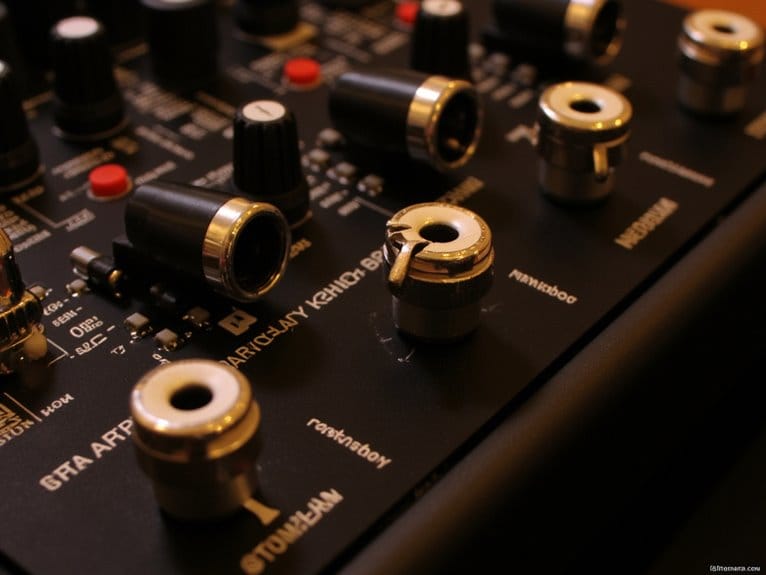XLR Vs USB Microphones: Pros and Cons
XLR microphones excel with superior audio fidelity, balanced signal transmission, and professional expandability through external preamps and interfaces, though they require additional equipment and higher initial investment. USB microphones offer plug-and-play convenience with built-in sound cards, making them ideal for immediate recording needs at lower costs, but they limit upgrade potential with internal ADC conversion and reduced flexibility. Your choice depends on balancing current convenience against future recording ambitions, and understanding these technical distinctions will guide you toward the ideal setup for your specific requirements.
We are supported by our audience. When you purchase through links on our site, we may earn an affiliate commission, at no extra cost for you. Learn more.
Notable Insights
- USB microphones offer plug-and-play convenience with immediate recording capability, while XLR mics require additional equipment like audio interfaces.
- XLR microphones deliver superior sound quality with balanced signal transmission and reduced electromagnetic interference compared to USB alternatives.
- USB mics have lower initial costs but limited upgrade potential, whereas XLR setups allow modular improvements over time.
- XLR systems excel in multi-microphone scenarios and professional environments, while USB mics suit individual recording and simple setups.
- XLR microphones provide greater flexibility for external processing equipment, but USB mics include built-in sound cards for streamlined operation.
Sound Quality and Audio Fidelity Differences
When it comes to sound quality, I’ve found that XLR microphones consistently deliver superior audio fidelity compared to their USB counterparts, primarily due to their balanced analog signal transmission and professional-grade components.
You’ll notice the difference immediately in frequency clarity, as XLR mics capture a wider range of audio frequencies with more precision than most USB models. The balanced three-pin cables inherently suppress electromagnetic interference, resulting in cleaner recordings with lower noise floors.
What really sets XLR setups apart is their sound depth—they reproduce subtle harmonics and overtones that USB microphones often miss. XLR microphones remain the studio standard for professional recording environments where audio quality is paramount.
While USB mics have improved considerably, their internal analog-to-digital converters typically can’t match the quality of dedicated audio interfaces paired with professional XLR microphones. The signal inversion technique used in XLR cables creates an out-of-phase configuration that effectively cancels out noise and interference during transmission.
Setup Complexity and User Experience
While superior audio quality matters tremendously, I’ve learned that the practical reality of actually getting your microphone up and running can make or break your entire recording experience, especially if you’re just starting out or need something that works immediately without fuss.
USB microphones deliver unmatched setup convenience through their plug-and-play design, requiring nothing more than connecting a single cable to your computer before you’re recording. These microphones often include built-in sound cards that handle audio processing internally, eliminating the need for external audio equipment and further simplifying the recording process.
USB microphones offer instant recording capability with zero technical barriers between you and your first professional-quality audio capture.
XLR microphones, however, demand additional equipment like audio interfaces or mixers, plus configuration of gain levels, phantom power settings, and signal routing options that can overwhelm newcomers. Audio interfaces with zero-latency monitoring capabilities help prevent timing issues during live recording, though this adds another layer of complexity to your setup. XLR setups also provide greater sound control through external preamps and processors, allowing for more precise audio manipulation. Professional interfaces typically feature metal chassis construction that provides better durability and reduces noise interference compared to plastic alternatives.
The user accessibility difference becomes stark when you’re troubleshooting issues, as USB problems typically involve simple driver installations while XLR setups require checking multiple components, cables, and software configurations simultaneously.
Flexibility and System Expandability
Beyond the immediate setup experience, I’ve discovered that your choice between XLR and USB microphones fundamentally shapes how your recording system can grow, adapt, and evolve over time. This becomes increasingly important as your needs become more sophisticated or your projects demand greater versatility.
XLR microphones offer extensive connectivity options, allowing you to integrate preamps, compressors, and external effects units while maintaining seamless hardware compatibility with professional audio gear like mixing consoles and interfaces.
You can expand from single-microphone setups to complex multi-source configurations, upgrading individual components without replacing entire systems. XLR systems excel at mixing multiple mics for interview setups or co-hosted shows where several voices need balanced integration. This expandability makes them particularly valuable for live performances where reliability and dynamic adaptability are essential. Professional audio interfaces can be daisy-chained to expand channel counts, allowing sophisticated recording setups to grow incrementally as your needs develop. Quality interfaces support 24-bit/192kHz recording capabilities that ensure your expanded setup maintains professional-grade audio specifications as you scale up your operations. USB microphones, while convenient, limit your expansion potential since they’re designed primarily for direct computer connection, restricting your ability to incorporate professional audio processing equipment or scale beyond basic recording scenarios.
Cost Analysis and Budget Considerations
Nothing quite forces a reality check like staring at your bank account while shopping for microphones, and I’ve learned that the initial sticker price represents just one piece of a much larger financial puzzle that unfolds differently depending on whether you choose XLR or USB technology.
Your budget constraints will immediately favor USB microphones, which typically cost less upfront and include built-in preamps, eliminating additional purchases. However, XLR setups require audio interfaces, cables, and potentially phantom power, substantially increasing total costs beyond the microphone itself.
| Cost Factor | USB Microphones | XLR Microphones |
|---|---|---|
| Initial Investment | $50-$300 | $100-$500 + interface |
| Required Accessories | USB cable, headphones | Interface, cables, stands |
| Upgrade Potential | Limited, replace entire unit | Modular component upgrades |
Smart audio investments consider long-term scalability, where XLR’s modular nature allows gradual improvements. Professional models like the Shure SM7B typically require a high gain preamp to achieve usable signal levels, adding another layer to your equipment budget. USB microphones offer single input recording capabilities, making them suitable for individual voice or instrument capture without the complexity of multi-channel setups. Budget-conscious users can achieve studio-quality results for under $200 when pairing XLR microphones with affordable audio interfaces. Consider that 24-bit recording capabilities are commonly found in both budget and premium interfaces, allowing professional-grade audio capture without breaking the bank.
Target Use Cases and Applications
When you’re choosing between XLR and USB microphones, understanding your specific content creation needs and professional audio requirements becomes the decisive factor that’ll guide your investment.
Whether you’re launching a weekly podcast from your bedroom, building a professional recording studio, or streaming gameplay to thousands of viewers, each application demands different levels of audio quality, expandability, and technical complexity.
I’ve found that matching your microphone choice to your actual use case, rather than buying based on what sounds most impressive, saves both money and frustration while ensuring you get the performance you actually need. Solo content creators like podcasters and online teachers typically find USB microphones ideal for home recording due to their convenience and straightforward setup process. XLR microphones excel when you need to record multiple participants simultaneously, making them the preferred choice for group interviews, roundtable discussions, and collaborative content creation.
Professional studios often require audio interfaces that can accommodate multiple XLR inputs and deliver the high-quality preamps necessary for professional-grade recordings. Modern audio interfaces offer 24-bit/96kHz recording capabilities that ensure studio-quality sound reproduction for demanding professional applications.
Professional Vs Consumer Requirements
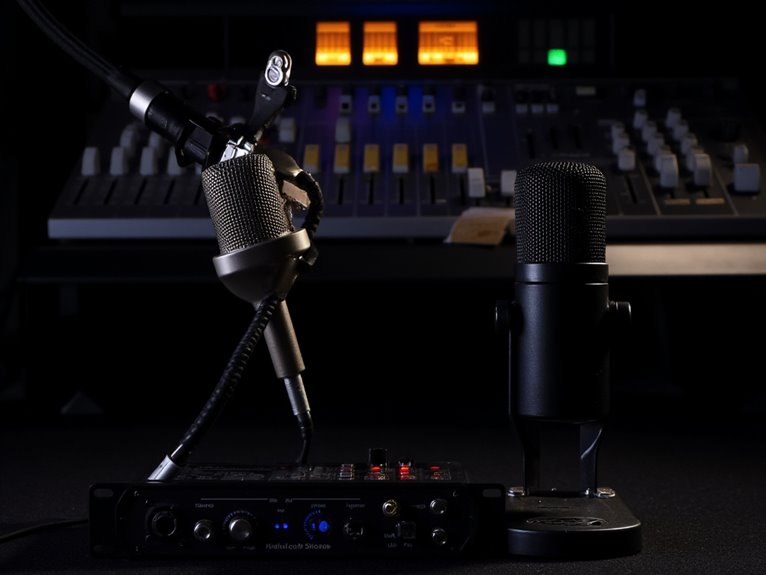
When I’ve worked with both professional studios and home setups over the years, I’ve noticed that the divide between XLR and USB microphones really comes down to what you’re trying to accomplish and how much flexibility you need in your audio chain.
Professional environments demand higher audio quality, signal integrity, and professional durability that can withstand rigorous daily use, frequent transportation, and diverse recording conditions. You’ll need expandability, custom sound shaping capabilities, and compatibility with mixers, preamps, and multi-channel interfaces. For professional applications, microphones with signal-to-noise ratios above 80 dB are essential for clarity in recordings and capturing expressive dynamics without background interference.
Consumer convenience drives USB microphone adoption, offering plug-and-play simplicity with integrated audio converters that eliminate additional equipment requirements.
While USB mics sacrifice some fidelity and upgrade flexibility, they provide immediate functionality for streaming, podcasting, and basic recording needs without investing in professional-grade audio interfaces. Most quality podcasting microphones offer dual connectivity options that support both USB and XLR connections, providing flexibility for users who want to start simple but upgrade their setup over time.
Making the Right Choice for Your Needs
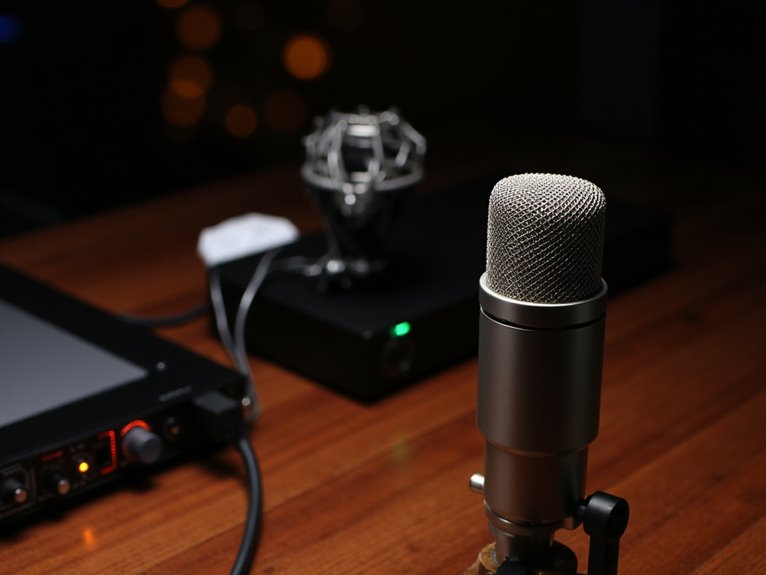
How do you cut through all the technical specifications and marketing claims to pick the microphone that’ll actually serve your specific recording goals? Your choice hinges on understanding your actual workflow, budget constraints, and future aspirations rather than chasing the latest features.
Focus on your actual workflow and budget constraints rather than chasing the latest microphone features and marketing hype.
Consider these critical factors when making your decision:
- Recording environment: Home office setups favor USB simplicity, while dedicated studios benefit from XLR flexibility.
- Content creation frequency: Daily podcasters need reliable plug-and-play solutions versus occasional streamers.
- Budget allocation: Upfront USB costs versus long-term XLR investment strategies.
- Technical comfort level: Your willingness to learn audio engineering fundamentals affects usability.
- Growth trajectory: Solo creators versus teams planning multi-microphone configurations.
Microphone durability and user preferences ultimately determine satisfaction more than raw specifications, making honest self-assessment essential.
Frequently Asked Questions
Can I Use XLR Microphones With Smartphones or Tablets?
You can absolutely use XLR microphones with smartphones or tablets, though you’ll need specific adapter requirements like XLR-to-3.5mm converters or dedicated interfaces such as iRig Pre 2.
I’ve found that while these setups require additional hardware and aren’t exactly plug-and-play, the audio quality improvement over built-in smartphone mics is substantial.
This makes them worthwhile for content creators seeking professional-grade mobile recording capabilities.
Do USB Microphones Work With Gaming Consoles Like Playstation or Xbox?
USB microphone compatibility with console gaming varies greatly between platforms, and you’ll need to verify specific model support before purchasing.
PlayStation consoles generally offer better USB accessory recognition than Xbox systems, which require Microsoft-approved devices for proper functionality.
I’ve found that many PC-focused USB mics won’t work seamlessly without additional adapters or configuration adjustments, so checking manufacturer documentation prevents costly compatibility disappointments.
Which Microphone Type Is Better for Recording in Noisy Environments?
For recording in noisy environments, you’ll want XLR microphones because they offer superior noise isolation through balanced signal transmission and external processing control.
I’ve found that XLR setups allow you to add dedicated preamps, compressors, and EQ hardware that dramatically improve sound clarity when background noise becomes problematic.
USB mics can’t match this flexibility since their fixed internal processing limits your ability to customize noise reduction effectively.
Can I Convert XLR Microphones to Work With USB Ports?
You can absolutely convert XLR microphones to work with USB ports using XLR adapters like the Shure MVX2U, which provides up to 60dB of gain and plug-and-play functionality.
Audio interfaces offer another reliable conversion method, connecting your XLR mic to computers via USB while maintaining professional sound quality.
I’ve found these solutions particularly effective for content creators who want XLR performance with USB convenience.
Do XLR or USB Microphones Last Longer Before Needing Replacement?
I’ve found that XLR microphones consistently outlast USB models in durability comparison, often lasting a decade or more with proper care, while USB mics typically need replacement within a few years.
The maintenance requirements for XLR setups are actually simpler since you can service individual components separately, whereas USB mics integrate everything into one unit that’s harder to repair when issues arise.
On a final note
You’ll find that choosing between XLR and USB microphones ultimately depends on your specific needs, budget constraints, and future aspirations. If you’re starting out with podcasting or streaming, USB mics offer simplicity and immediate results, while XLR systems provide professional flexibility and superior audio quality for serious content creators. Consider your current skill level, available space, and long-term goals before making this investment decision.

